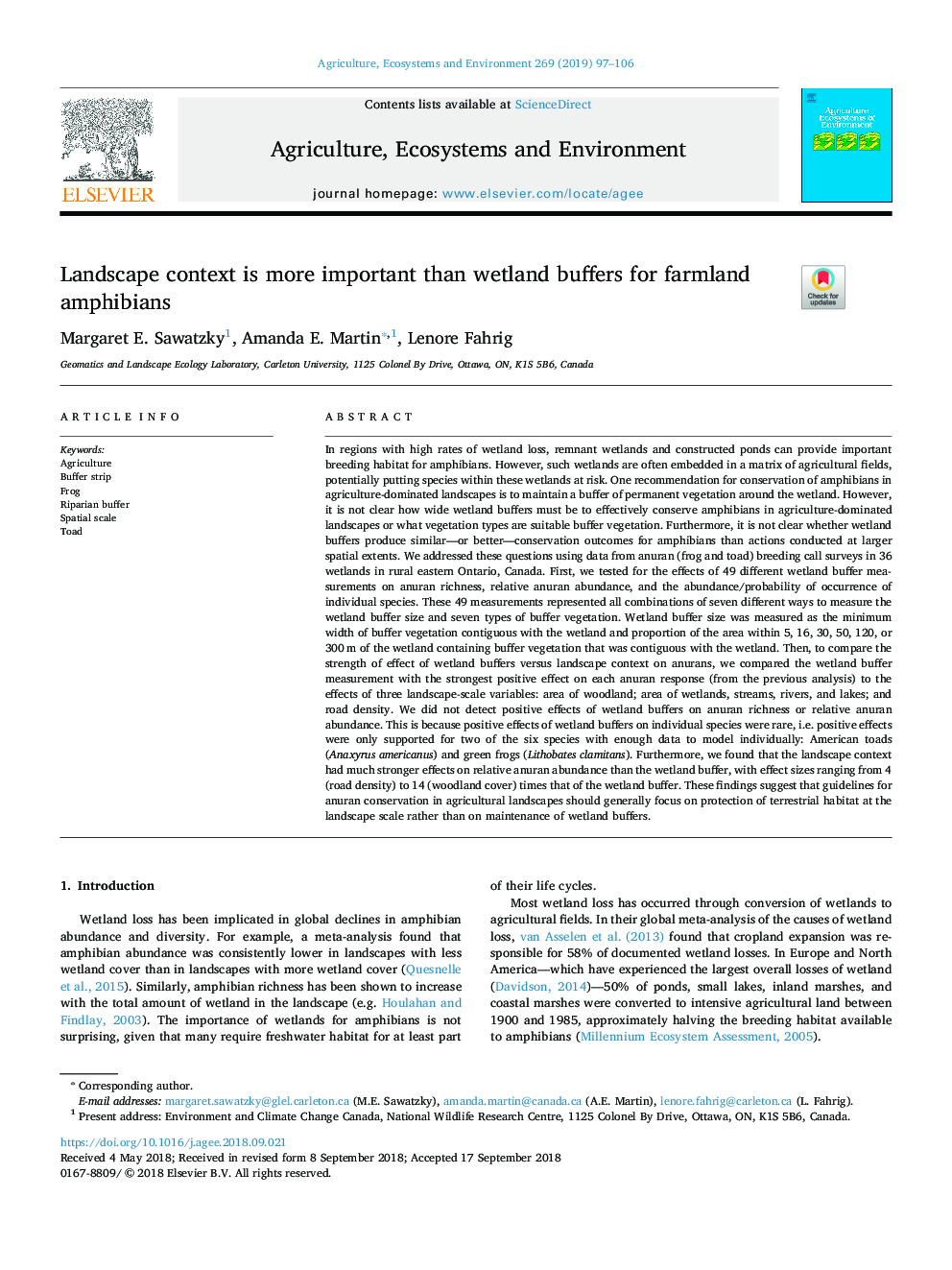| کد مقاله | کد نشریه | سال انتشار | مقاله انگلیسی | نسخه تمام متن |
|---|---|---|---|---|
| 10970598 | 1104192 | 2019 | 10 صفحه PDF | دانلود رایگان |
عنوان انگلیسی مقاله ISI
Landscape context is more important than wetland buffers for farmland amphibians
ترجمه فارسی عنوان
زمینه چشم انداز مهمتر از بافرهای تالاب برای دوزیستان مزرعه است
دانلود مقاله + سفارش ترجمه
دانلود مقاله ISI انگلیسی
رایگان برای ایرانیان
کلمات کلیدی
کشاورزی، نوار بافر، قورباغه بافر غلیظ مقیاس فضایی، عصاره،
موضوعات مرتبط
علوم زیستی و بیوفناوری
علوم کشاورزی و بیولوژیک
علوم زراعت و اصلاح نباتات
چکیده انگلیسی
In regions with high rates of wetland loss, remnant wetlands and constructed ponds can provide important breeding habitat for amphibians. However, such wetlands are often embedded in a matrix of agricultural fields, potentially putting species within these wetlands at risk. One recommendation for conservation of amphibians in agriculture-dominated landscapes is to maintain a buffer of permanent vegetation around the wetland. However, it is not clear how wide wetland buffers must be to effectively conserve amphibians in agriculture-dominated landscapes or what vegetation types are suitable buffer vegetation. Furthermore, it is not clear whether wetland buffers produce similar-or better-conservation outcomes for amphibians than actions conducted at larger spatial extents. We addressed these questions using data from anuran (frog and toad) breeding call surveys in 36 wetlands in rural eastern Ontario, Canada. First, we tested for the effects of 49 different wetland buffer measurements on anuran richness, relative anuran abundance, and the abundance/probability of occurrence of individual species. These 49 measurements represented all combinations of seven different ways to measure the wetland buffer size and seven types of buffer vegetation. Wetland buffer size was measured as the minimum width of buffer vegetation contiguous with the wetland and proportion of the area within 5, 16, 30, 50, 120, or 300âm of the wetland containing buffer vegetation that was contiguous with the wetland. Then, to compare the strength of effect of wetland buffers versus landscape context on anurans, we compared the wetland buffer measurement with the strongest positive effect on each anuran response (from the previous analysis) to the effects of three landscape-scale variables: area of woodland; area of wetlands, streams, rivers, and lakes; and road density. We did not detect positive effects of wetland buffers on anuran richness or relative anuran abundance. This is because positive effects of wetland buffers on individual species were rare, i.e. positive effects were only supported for two of the six species with enough data to model individually: American toads (Anaxyrus americanus) and green frogs (Lithobates clamitans). Furthermore, we found that the landscape context had much stronger effects on relative anuran abundance than the wetland buffer, with effect sizes ranging from 4 (road density) to 14 (woodland cover) times that of the wetland buffer. These findings suggest that guidelines for anuran conservation in agricultural landscapes should generally focus on protection of terrestrial habitat at the landscape scale rather than on maintenance of wetland buffers.
ناشر
Database: Elsevier - ScienceDirect (ساینس دایرکت)
Journal: Agriculture, Ecosystems & Environment - Volume 269, 1 January 2019, Pages 97-106
Journal: Agriculture, Ecosystems & Environment - Volume 269, 1 January 2019, Pages 97-106
نویسندگان
Margaret E. Sawatzky, Amanda E. Martin, Lenore Fahrig,
